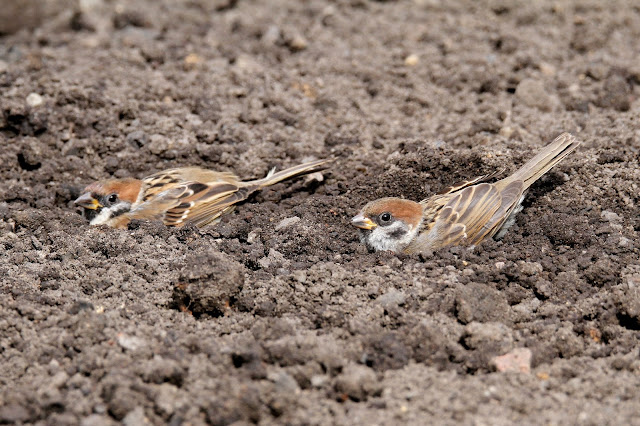The tree sparrow chicks in the last three nest boxes in the garden have fledged in this past week. I think these were all third broods although it isn't always easy to keep track of what they are up to.
I noticed the sparrowhawk in yesterday's post has been hanging around in the kitchen garden this week - he must have known the chicks were about to fledge. They were certainly making a lot of noise and they attracted attention from this woodpecker as well.
The chicks' first flight was as far as the fence where they sat and wondered what to do next.
I have been offering the sparrows red millet seed recently and they seem quite pleased with it.
The first chicks fledged at the end of May so they are now well able to look after themselves.
The newest chicks can fly to the feeder but can't feed themselves.
The sparrows are very keen on taking dust baths at this time of year. It helps to remove parasites from their feathers.
The dust-bathing sparrows attracted a lot of interest. They were watched in their baths by a very puzzled young blackcap,
a woodpigeon,
a robin,
and a rather suspicious young willow warbler. It is a good job they are not shy.
Here is a brief video of a young sparrow trying out a dust bath yesterday, even though the soil isn't really dusty enough.
Tree sparrows are in trouble, having suffered a catastrophic decline in numbers in the 1970s and 1980s. They are on the UK Red List because of population decline.
The picture is more promising when you look at BTO Garden BirdWatch data for the North East of England for recent years. Tree sparrows moved into my garden in spring 2012 and have been here ever since.
Tree sparrows are now largely absent from the south of the country and seem to prefer eastern parts of Northern England, Scotland and Ireland.
The tree sparrow is Passer montanus and in Thomas Bewick's time it was known as the mountain sparrow. It is interesting that its distribution was very different in those days, almost the opposite of how it is now. Bewick wrote
This is Bewick's illustration for A History of British Birds published in 1797.
The tree sparrow's call and song obviously aren't interesting enough for it to be included in the recordings at the British Library but you can hear it here. It has also featured on the BBC Radio 4 Tweet of the Day as you can hear here.
The garden has been full of tree sparrows this week, great to see.



























Ours had a third brood too!
ReplyDelete